Findians, Finglish, Finntowns
16 May 2013 | Extracts, Non-fiction
Workers, miners, loggers, idealists, communists, utopians: early last century numerous Finns left for North America to find their fortune, settling down in Michigan, Minnesota, Wisconsin and Ontario. Some 800,000 of their descendants now live around the continent, but the old Finntowns have disappeared, and Finglish is fading away – that amusing language cocktail: äpylipai, apple pie.
The 375th anniversary of the arrival of the first Finnish and Swedish settlers, in Delaware, was celebrated on 11 May. Photographer Vesa Oja has met hundreds of American Finns over eight years; the photos and stories are from his new book, Finglish. Finns in North America

Drinking with the workmen: The Työmies Bar. Superior, Wisconsin, USA (2007)
The Työmies Bar is located in the former printing house of the Finnish leftist newspaper, Työmies (‘The workman’). The owners, however, don’t know what this Finnish word means, or how to pronounce it.
The Työmies Society, which published the newspaper of the same name, Työmies, was founded in Worcester, Massachusetts in 1903 as a socialist organ. It moved to Hancock, Michigan the following year.
Partly as a result of the hostile climate prevailing in Hancock, partly because of the failure of the copper strike of 1913–1914, the newspaper was moved to Superior, Wisconsin in 1914. In 1950 Työmies, by then a Communist newspaper, was merged with another Communist organ, Eteenpäin (‘Forwards’), in Yonkers, New York, to create Työmies-Eteenpäin. It continued to be published from Superior, Wisconsin into 1995.
Finnish American Reporter, which began as an insert to Työmies-Eteenpäin in 1986, was intentionally created as an English-language newspaper for all Finns without political or religious affiliation – so it is a separate paper from Työmies-Eteenpäin. In 2000, the Finnish American Reporter and all its assets were signed over by the Työmies Society to Suomi College (Finlandia University), which used to be the Työmies Society’s bitter enemy.
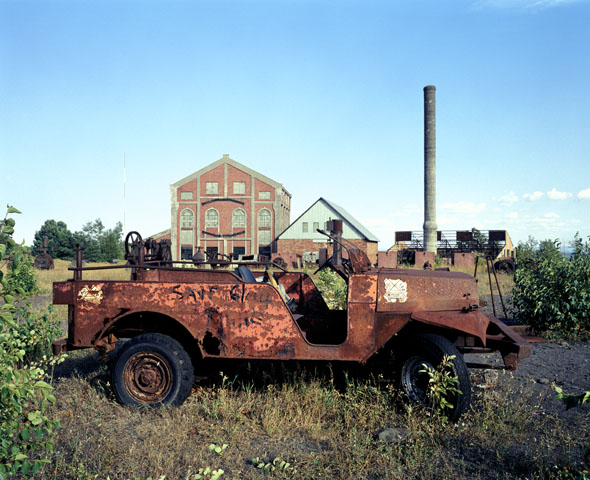
Former glory: Quincy Mine, Hancock, Michigan, USA (2005). Photo: Vesa Oja
Located on the Keweenaw Peninsula, Hancock was a center for the Copper Country Finns in the Upper Peninsula of Michigan. Keweenaw was known among the Finns as Kuparisaari (Copper Island) and there were many mining towns and logging sites there. A great number of Finns worked in the mines throughout the heyday of the mining industry. In the early days, the Finns called Hancock ‘Amerikan Lappi’ (The Lapland of America).
Dating from 1896, Suomi College (present-day Finlandia University) was founded and led by Finnish clergymen to give local young people a chance for higher education and a better life. One of the core missions of Suomi College was to train Lutheran clergymen. English was also taught there. Pastor Rudolf Kemppainen playfully called Suomi College ‘the Finnish shoe factory’, because it produced so many pairs (married couples).
The Finnish American Heritage Center & Historical Archive at Finlandia University is the present-day hub of local Finnish American activities, as well as one of the larger repositories of Finnish American archival materials and art. The monthly Finnish American Reporter is published in Hancock.
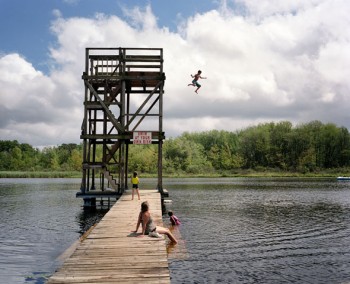
Still swimming: Finn Camp, Wixom, Michigan, USA (2010). Photo: Vesa Oja
Between Loon Lake and Sun Lake there is a narrow, boggy isthmus where the Finns of the 14th Street Hall in Detroit established the Detroit Finnish Co-operative Summer Camp Association and its resort site.
At first, in the 1920s, families spent the summer here in tents while the men went to work in the city. The area was gradually developed, with a sauna and pier first, followed by a diving tower. The swimming site is warmly remembered – regardless of political affiliation. A dance hall and a sports ground were later built volunteers.
The athletics field was built on boggy ground, which had to be filled with wrecked cars. Golf, baseball and football were played; the Voima athletics club is still active. There were several outdoor dance floors, because the venues had to be changed according to the mosquito situation. There were weekly dances and theatrical performances in the hall. The tents were replaced by small cabins, which finally numbered over a hundred.
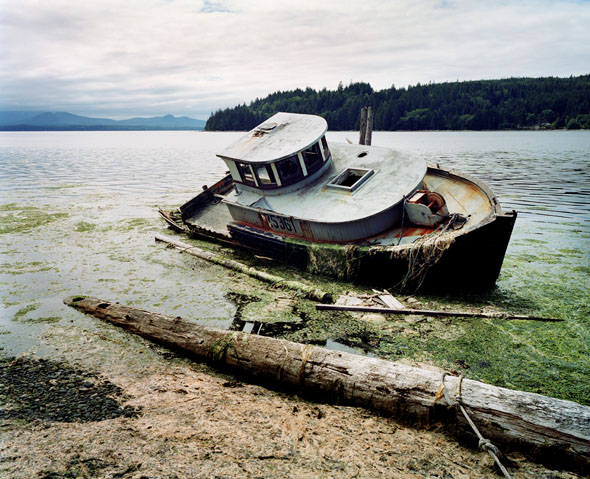
Utopia deserted: Sointula, British Columbia, Canada (2006). Photo: Vesa Oja
Matti Kurikka was a charismatic Finnish Labour leader whom the local Finnish miners invited to lead an association on Malcolm Island, northeast of Vancouver island, at the beginning of the 20th century. At first, 150 people settled there, braving severe conditions to create a new future as a utopian community named Sointula. The settlers, who called themselves the People of Kaleva, and elected as their leader Matti Kurikka, who instilled faith in their opportunities, even though the land was almost untillable.
Within a few years, the extremely difficult conditions, a fire that destroyed the colony’s dormitory and bad luck with finances undermined Kurikka’s position as leader. His ideas on gender equality spread outside the community and were thought to advocate the sharing of wives. Finally, unsuccessful bridge-building ventures on the mainland wrecked trust in Kurikka’s leadership, and he was forced to leave the island.
After Kurikka and his supporters left the island following the utopian experiment, new livelihoods began to evolve in Sointula from fishing, boat building and logging. There are still some 200 descendants of the Finns on the island, of whom approximately 40 speak Finnish. In the late 1960s, young Americans avoiding the war in Vietnam moved to the island, which became an interesting mixture of the descendants of Finnish utopian socialists and American hippies.
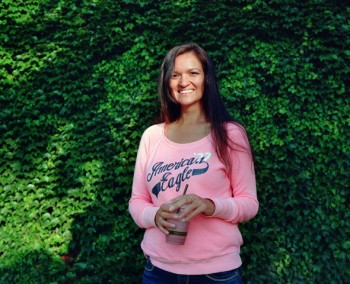
A Findian: Aliina Charging Hawk, Duluth, Minnesota, USA (2011). Photo: Vesa Oja
Aliina studies chemistry and pharmacy at the University of Duluth. She misses, however, the Deer River and the nearby Leech Lake Indian Reservation, where her 13- and 3-year-old children are waiting for her. She feels lost in the city in other ways, too.
She worked for eight years in a casino, but went on to study, because she wants to become a pharmacist. She also wants to help the people of the reservation.
Aliina is a Findian; her father is Sioux-Lakota and her mother is of Finnish ancestry.
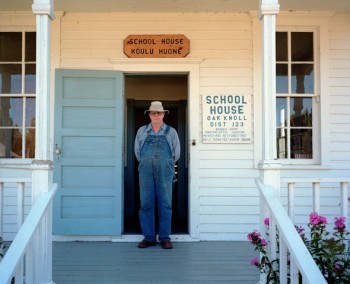
Finn Creek: Raymond Bentley, New York Mills, Minnesota, USA (2011). Photo: Vesa Oja
Raymond Bentley’s grandmother’s place, the old Tapio farm, is now the Finn Creek Open Air Museum. His mother was born there, the daughter of Siffert from Jurva, and Wilhelmiina, from Ii in Northern Finland. They were granted the homestead in 1900.
Raymond Bentley’s parents were Norman and Tekla Bentley. The father’s family was originally named Penttilä. One of Raymond’s nephews recently changed his name back to Penttilä.
Raymond (85) spent his whole working life as a first mate of an iron freighter on the Great Lakes. He would sail seven days a week from Marquette to Cleveland and Buffalo; his only longer holidays at home were at Christmas time. Now in retirement, he volunteers at the Finn Creek Museum.
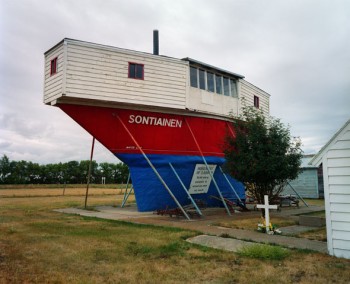
Homeward bound: Moose Jaw, Saskatchewan, Canada (2011). Photo: Vesa Oja
Sontiainen is an amusing, intriguing and tragic story of homesickness. The unfortunate Tom Sukanen had lost his family. Studying the map [in the 1940s], he noticed he could return to Finland by ship from the middle of Canada. The vessel would first have to be dragged 17 miles to a river leading to the Arctic Ocean and from there back home to Finland. The boat was fitted out for Sukanen and his horse.
Sukanen never managed to get the vessel to the river. He now lies buried next to his boat, Sontiainen (Finnish for ‘dung beetle’)
Vesa Oja
Finglish. Finns in North America. Pohjois-Amerikan suomalaisia
The stories behind the photos: Päivi Oja
Helsinki: Musta Taide / Aalto ARTS Books, 2013. 239 p., ill.
Graphic design: Jorma Hinkka, Graafiset Neliöt Oy
English translation: Jüri Kokkonen
ISBN 978-952-292-002-7
The exhibition Finglish is open until 28 July at the Finnish Museum of Photography, Helsinki.
Tags: cultural history, history, photography
5 comments:
Trackbacks/Pingbacks:
-
Findians, Finglish, Finntowns | Delaware Online
17 May 2013 on 9:42 am[…] Delaware Online Headlines […]

22 May 2013 on 11:53 am
Thank you, this is so interesting! Many present day Finns don’t know anything about the rich history of Finnish Americans.
23 May 2013 on 4:41 pm
I am a descendent one of those Finns who migrated to North America in the early 1900’s. My grandfather, Lauri Halonen, came to Northern Ontario to work for the Canadian Pacific Railway. He moved to a small town on the north shore of Lake Superior, Schreiber. He and my grandmother Maria (Sirkka) had several children, who in turn had several children and so on. The Halonen family in Canada and the US is now a large and dispersed group with its own website, http://www.halonenfamily.org. Visit us.
23 June 2013 on 6:13 pm
I would like to know how to purchase a copy of the book Finglish by Vesa Oja.
Kiitos
27 June 2013 on 1:28 pm
Dear Gloria,
try the Academic Bookstore in Helsinki:
https://akateeminen.com/webapp/wcs/stores/servlet/en/akateeminencom-akasales
1 February 2016 on 4:53 am
I find these stories interesting. Wish I would know where to find more information about us Finns in Canada and USA. One thing I must admit is that I have not, intentionally, learned Finglish, although know it quite well – “Kyllä meellä on kolomen petiruuma houssi, yks niistä upsteella. Ja kahen auton kraatsi. Karpitsit pittää viijä highwain varteen.” Someone gave me a book in Finglish and I find it fascinating to read.
I came to Canada in 1968 so I am a very new Finn abroad, and was fortunate, through internet, find relatives from my father’s side in Montana, Minnesota and Michigan. I am a Canadian Finn!